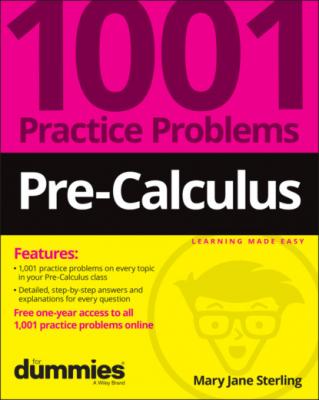ТОП просматриваемых книг сайта:
Pre-Calculus: 1001 Practice Problems For Dummies (+ Free Online Practice). Mary Jane Sterling
Читать онлайн.Название Pre-Calculus: 1001 Practice Problems For Dummies (+ Free Online Practice)
Год выпуска 0
isbn 9781119883647
Автор произведения Mary Jane Sterling
Жанр Математика
Издательство John Wiley & Sons Limited
386. A normal conversation is 60 decibels (dB). What is the intensity of the sound of the conversation (in watts per square meter)? Use the following formula, where L is decibels and I is the intensity of the sound:
387. Two earthquakes occurred in different parts of the country. The first earthquake had a magnitude of 8.0, and the second had a magnitude of 4.0. Compare the intensity of the earthquakes using the equation
388. A town had a population of 6,250 in 1975 and a population of 8,125 in 2010. If the rate of growth is exponential, what will the population be in 2040? Use the exponential model
389. In 2000, a house was appraised at $179,900. In 2013, it was reappraised at $138,000. If the decline rate is exponential, what will the value of the house be in 2020? Round the value to the nearest dollar. Use the exponential model
390. One student with a contagious flu virus goes to school when they’re sick. The school district includes 7,500 students and 1,000 staff members. The growth of the virus is modeled by the following equation, where y is the number infected and t is time in days:
Chapter 7
Trigonometry Basics
Trigonometric functions are special in several ways. The first characteristic that separates them from all the other types of functions is that input values are always angle measures. You input an angle measure, and the output is some real number. The angle measures can be in degrees or radians — a degree being one-360th of a slice of a circle, and a radian being about one-sixth of a circle. Each type has its place and use in the study of trigonometry.
Another special feature of trig functions is their periodicity; the function values repeat over and over and over, infinitely. This predictability works well with many types of physical phenomena, so trigonometric functions serve as models for many naturally occurring observations.
The Problems You’ll Work On
In this chapter, you’ll work with trigonometric functions and their properties in the following ways:
Defining the basic trig functions using the sides of a right triangle
Expanding the input values of trig functions by using the unit circle
Exploring the right triangle and trig functions to solve practical problems
Working with special right triangles and their unique ratios
Changing angle measures from degrees to radians and vice versa
Determining arc length of pieces of circles
Using inverse trig functions to solve for angle measures
Solving equations involving trig functions
What to Watch Out For
Don’t let common mistakes trip you up; keep in mind that when working with trigonometric functions, some challenges will include the following:
Setting up ratios for the basic trig functions correctly
Recognizing the corresponding sides of right triangles when doing applications
Remembering the counterclockwise rotation in the standard position of angles
Measuring from the terminal side to the x-axis when determining reference angles
Keeping the trig functions and their inverses straight from the functions and their reciprocals
Using Right Triangles to Determine Trig Functions
391−396 Use the triangle to find the trig ratio.
391.
Illustration by Thomson Digital
392.
Illustration by Thomson Digital
393.
Illustration by Thomson Digital
394.
Illustration by Thomson Digital
395.
Illustration by Thomson Digital
396.
Illustration by Thomson Digital
Solving Problems by Using Right Triangles and Their Functions
397−406 Solve the problem. Round your answer to the nearest tenth unless otherwise indicated.
397. A ladder leaning against a house makes an angle of 30° with the ground. The foot of the ladder is 7 feet from the foot of the house. How long is the ladder?
398. A child flying a kite lets out 300 feet of string, which makes an angle of 35° with the ground. Assuming that the string is straight, how high above the ground is the kite?
399. An airplane climbs at an angle of 9° with the ground. Find the ground distance it has traveled when it reaches an altitude of 400 feet.
400. A car is traveling up a grade with an angle of elevation of 4°. After traveling 1 mile,

